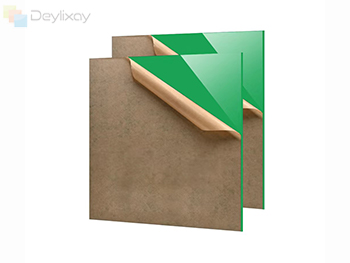Acrylic sheets, often popularly known by the brand name plexiglass, are one of the most versatile and useful materials for DIY enthusiasts, builders, and designers. However, despite its popularity, a cloud of misinformation often surrounds it.

Believing these common myths can lead you to make the wrong choice for your project or miss out on the incredible benefits this material offers. It's time to separate fact from fiction. Let's debunk the most persistent myths about Acrylic sheets.
Myth #1: "Acrylic is just a cheap, weak version of glass."
The Myth: Many people assume that because acrylic is a plastic, it's an inferior and fragile substitute for real glass.
The Fact: This couldn't be further from the truth. While it is an affordable option, "weak" is the last word to describe it. Acrylic is 10 to 20 times more impact-resistant than glass. A sheet of acrylic can withstand significant force that would shatter a glass pane of the same thickness. This makes it a much safer option for homes with children, high-traffic areas, or applications where breakage is a concern. It's not a weak imitation; it's a smart, durable upgrade.
Myth #2: "Acrylic scratches easily and is impossible to maintain."
The Myth: You've probably heard that acrylic is a nightmare to keep looking nice because it scratches if you even look at it wrong.
The Fact: It's true that acrylic is softer than glass and more susceptible to surface scratches. However, this is often overstated. Modern acrylic sheets often come with a protective film that should be left on during fabrication and installation. More importantly, light surface scratches can be easily polished out. Using a specialized plastic polish or even a mild abrasive like toothpaste can often restore the surface to a like-new finish—something impossible to do with a scratched glass window.
Myth #3: "All acrylic will turn yellow and cloudy outdoors."
The Myth: Many believe that if you use acrylic outside, it will quickly degrade, turn yellow, and lose its clarity.
The Fact: This is a classic case of mistaken identity. This myth likely stems from experiences with other plastics like polycarbonate (which requires a UV coating to prevent yellowing) or low-grade, non-UV-stable acrylic. High-quality, virgin acrylic sheets have excellent inherent resistance to UV radiation. They are specifically formulated to resist yellowing and clouding for a decade or more, which is why they are the material of choice for permanent outdoor signage, skylights, and museum display cases.
Myth #4: "Plexiglass and all other acrylic sheets are exactly the same."
The Myth: A sheet labeled "Plexiglass" is identical to any other generic "acrylic sheet" on the market.
The Fact: As we've explored before, "Plexiglass" is a brand name, much like "Kleenex." While the base material is the same (PMMA), the quality and manufacturing process vary significantly.
Cell Cast vs. Extruded: Cell cast acrylic (often used for Plexiglas®) is typically higher quality, offers better optical clarity, and is more fabricator-friendly. Extruded acrylic is more common and cost-effective but may have slight variations in thickness and be more prone to cracking during cutting.
Virgin vs. Recycled: Sheets made from 100% virgin material offer superior clarity and longevity, while those containing recycled content may be more prone to yellowing and internal imperfections.
Myth #5: "Acrylic is very difficult to work with for DIY projects."
The Myth: You need a professional workshop and specialized tools to cut and shape acrylic.
The Fact: Acrylic is one of the most DIY-friendly materials available! Unlike glass, which requires special cutters and poses a risk of shattering, acrylic can be easily worked with standard home tools.
Cutting: You can score and snap thin sheets with a utility knife. For straight cuts, a circular saw or table saw with a fine-toothed blade works perfectly.
Drilling: Standard drill bits can be used, though carbide-tipped bits are best to prevent chipping on the backside.
Bending: You can create clean, professional bends by gently heating the material along a line with a simple heat gun.
Myth #6: "Acrylic panels look cheap and unprofessional."
The Myth: The visual appeal of acrylic can't compare to the premium look of real glass.
The Fact: High-quality acrylic is renowned for its optical clarity, allowing around 92% of light to pass through—even more than glass! Its lightweight nature allows for sleek, modern designs that would be impossibly heavy and expensive with glass. From minimalist display shelves to stunning contemporary room dividers and brilliant protective barriers that are virtually invisible, acrylic offers a clean, high-end aesthetic that is preferred by architects and designers worldwide.
Don't let outdated myths prevent you from using one of the most versatile, durable, and beautiful materials on the market. Acrylic sheet (Plexiglass) is not just a substitute; it's often the superior choice for a wide range of applications, from home DIY to professional installations.
By understanding the facts, you can confidently choose acrylic for your next project, knowing you're selecting a material that is strong, safe, crystal-clear, and built to last.
 English
English Español
Español Portugues
Portugues Pусский
Pусский Français
Français Deutsch
Deutsch 日本語
日本語 한국어
한국어 العربية
العربية Italiano
Italiano Nederlands
Nederlands Ελληνικά
Ελληνικά Svenska
Svenska Polski
Polski ไทย
ไทย Türk dili
Türk dili हिन्दी
हिन्दी Indonesia
Indonesia Melayu
Melayu Tiếng Việt
Tiếng Việt dansk
dansk Magyar
Magyar қазақ
қазақ বাংলা
বাংলা עִברִית
עִברִית မြန်မာ
မြန်မာ українська
українська norsk
norsk Gaeilge
Gaeilge Română
Română ພາສາລາວ
ພາສາລາວ Filipino
Filipino Suomalainen
Suomalainen slovenský
slovenský o'zbek
o'zbek Igbo
Igbo Hrvatski
Hrvatski Zulu South Africa
Zulu South Africa lëtzebuergesch
lëtzebuergesch тоҷикӣ
тоҷикӣ नेपाल
नेपाल Eesti
Eesti Yoruba
Yoruba Монгол
Монгол ខ្មែរ
ខ្មែរ 中文(繁体)
中文(繁体) Afrikaans
Afrikaans













 Umnxeba
Umnxeba
Comment
(0)